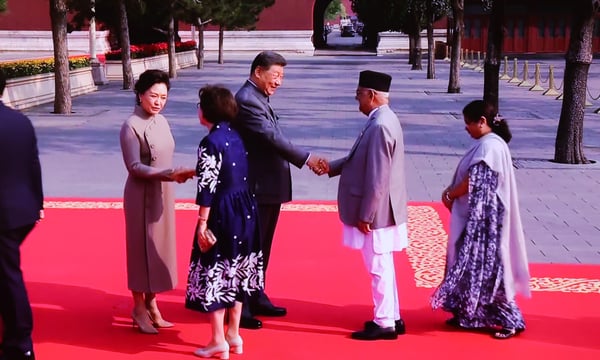For the third time in four years, a government has fallen in South Asia amid mass protests and demonstrations. The resignation of Nepal’s Prime Minister K.P. Sharma Oli came in the aftermath of tragic repression of a Gen Z protest, against rising corruption and restrictions on free speech (including a ban on social media platforms). Much like in Sri Lanka and Bangladesh, a slowdown in economic growth and job opportunities for the youth have been long-standing pain points in Nepal, where an unemployment rate stuck at over 10 percent since 2004 has caused heavy dependence on remittances and external assistance.
But there is also an important external context to all these crises. Given their developmental needs and domestic political imperatives, Sri Lanka, Bangladesh and Nepal have in the past years all experimented with different foreign policy balancing and hedging strategies, alternating engagements with India, China, and other powers amidst geopolitical competition. Hence, the structural challenge in South Asia is that of states with limited capacity caught between economic stagnation, restless youth populations, and a rising number of external players exerting pressure over domestic decision-making – including critical choices in the infrastructure, energy, technology, and other governance sectors.
Nepal’s domestic political crisis is thus indicative of the deeper churning in the region. There are obvious implications for India, the next-door neighbor. But there are also growing considerations for China, Nepal’s other neighbor. Even though China’s role in South Asia has grown in the last decade, with offers of alternative models of financing and development governance, there is little by way of policy or strategy when it comes to Beijing dealing with political instability in South Asia.
Nepal signed on in 2017 to the Belt and Road Initiative involving key infrastructure projects like highways, electricity transmission lines, railways, and hydroelectric plants, although there’s been little progress on concrete projects since. At the same time, China has also made inroads in the cultural and education sectors by engaging in heritage rebuilding and offering scholarships and language training to Nepali students. More crucially, the International Department of the Chinese Communist Party has pursued close party-to-party diplomacy, building ties with the Nepali elites. Oli visited China in 2024 and 2025, including to attend the military parade in Beijing that marked the 80th anniversary of the end of World War II.
However, China’s response to Nepal’s political crisis was rather muted, contrasting with its past attempts to intervene and even mediate in the country’s political affairs. Chinese Foreign Ministry spokesperson Lin Jian labeled the anti-government protests as “demonstrations,” expressing hope that “social order and national stability” will be restored soon for the benefit of the regional countries. In the aftermath of the appointment of Sushila Karki as the interim prime minister, the Foreign Ministry stated that “China, as always, respects the development path chosen independently by the people of Nepal.”
This is a trend reflected in China’s diplomatic activity in other smaller states in South Asia as well, for instance during the 2024 protests in Bangladesh. It could be interpreted in two ways. According to the official line, China has taken the stance of political noninterference. However, in the last few years, Chinese embassies have also sought to share lessons from the CCP’s governance experience and Chinese style modernization as pathways for countries to achieve their national development. China has also often sought to act as a political conflict mediator, for instance in the case of the civil war in Myanmar, where it has extensive economic interests. China’s silence on the mass protests is thus noticeable compared to its activities in the region under normal circumstances.
This brings us to the second interpretation. As former Indian diplomat Jagat Mehta noted in the 1980s, South Asia is not always an easy region for China to understand from a political perspective. For a regime that prioritizes social order and stability over all else, the pluralist, democratic, and politically volatile context of South Asia has proved challenging to China’s attempts to build long-term partnerships with a stable set of partners. It puts an extra onus on China to tread carefully and balance its relations with multiple stakeholders to preserve its expanding stakes in the region.
While China’s official discourse demonstrates formal respect for different South Asian “social systems,” there is also an implicit reference to the superiority of its own governance system. Beijing suggests that its model of concentrated power and policy coherence is superior to the “Western” model of governance and development based on free elections and competitive, multiparty democracy. This perspective does not always glue well with the reality of South Asia today.
Even as there is a huge demand for economic development, infrastructure, social mobility and betterment of life across the region, there is also a strong push to preserve the democratic ethos and resist authoritarian tendencies. As the political upheavals in Sri Lanka, Bangladesh, and Nepal have shown, any type of political restrictions, including bans on social media and constraints on free speech have faced massive opposition and – in the case of Nepal – added further fuel to the fire.
It thus remains to be seen to what extent the CCP’s strategy of cultivating political elites from all political ideologies could fall short in moments of transformative politics, such as those seen in Nepal last week. While the future is unclear, the protest movement succeeded in their immediate objective: to overhaul a system ridden by corruption, bureaucratic apathy, and the danger of authoritarianism. This is a challenge that the Chinese leadership must contend with, especially as their economic interests in the region expand and newer strategies like the Global Governance Initiative take shape.
China’s cautious but persistent projection of its governance model highlights both the appeal and the limits of authoritarian stability in a South Asian region where democratic aspirations remain deeply embedded. As the political future of Nepal settles over the next weeks and months, it will become clearer what role China seeks to play, either in the open or behind the scenes. For now, the developments in Kathmandu indicate that Beijing might be waiting and watching, as well as learning on how best to deal with South Asia’s persistent political pluralism.






